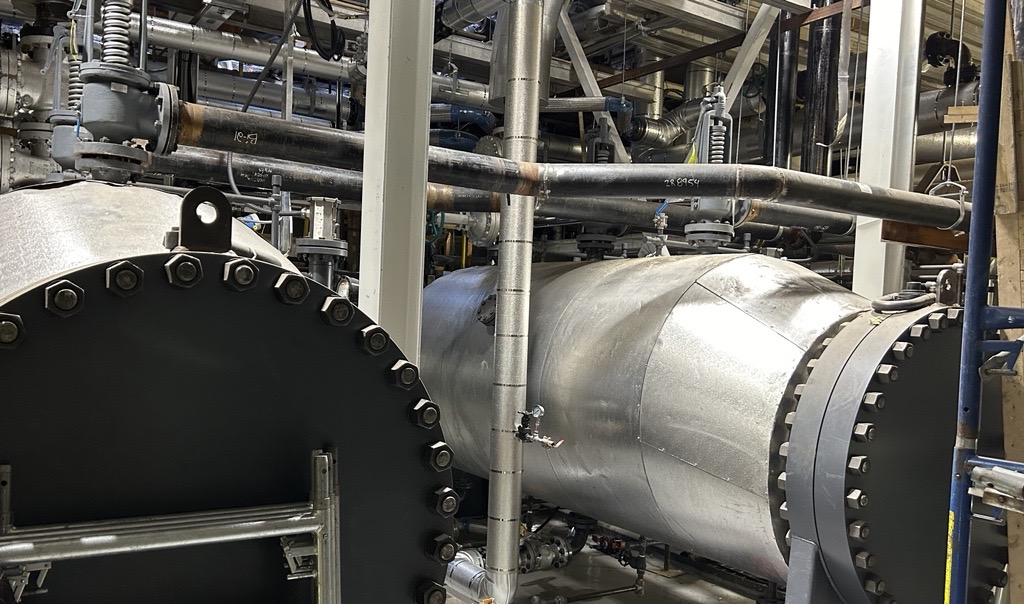
Tucked away behind the McCall MacBain Arts Building, largely out of sight and out of mind, is the second-largest heating plant on the island of Montreal. Boilers in the Ferrier Building’s powerhouse generate steam that is circulated through a network of tunnels to heat most of the buildings on the downtown campus.
These boilers, fuelled by natural gas, have accounted for about 65 per cent of the greenhouse-gas emissions generated by the University’s buildings; about two-thirds of McGill’s GHG emissions come from its buildings’ energy use.
But that is about to change.
McGill is reducing its carbon footprint by installing two new electric boilers. Delivered to the McGill campus this past fall and expected to go into operation in the coming months, they are part of a $33 million project financed primarily by the Quebec government, with additional support from the government of Canada. The project also includes the installation of heat-recovery systems on the two large natural-gas boilers that will remain in operation. A third large natural gas boiler was removed to make room for the two new electric boilers, while a smaller one, used mainly in the summer for lab sterilization needs and domestic hot water, will remain in use.
“This boiler project is one key part of achieving carbon neutrality by 2040,” said François Miller, McGill’s Executive Director of Sustainability.
“As an institution of higher education, we are in tune with the research that’s being produced here alerting us to the climate crisis, and we’re acting accordingly,” Miller said.
Nearly a third less downtown emissions
 The project is expected to cut 29 per cent of the downtown campus’s energy-related emissions from buildings, compared to 2022. That’s a reduction of 9,000 tonnes of CO2 equivalent annually, roughly equivalent to the emissions from 2,000 gasoline-powered passenger vehicles driven for one year.
The project is expected to cut 29 per cent of the downtown campus’s energy-related emissions from buildings, compared to 2022. That’s a reduction of 9,000 tonnes of CO2 equivalent annually, roughly equivalent to the emissions from 2,000 gasoline-powered passenger vehicles driven for one year.
In the meantime, considerable work is required to get the boilers up and running. There are connections to be made and a series of tests to be conducted.
“It’s a lot more complicated than it seems. It’s not like you just plug it into the wall and you press start,” Miller observed.
Among the issues to be addressed is how to reconfigure the power distribution on campus, says Jérôme Conraud, McGill’s Senior Consultant, Infrastructure Management and Strategic Planning, who is playing a key role in the project’s implementation.
Three main power lines serve the portion of the campus located below des Pins and Docteur-Penfield avenues, he said. Discussions are underway with Hydro-Québec as to how to free up capacity to power the electric boilers, in addition to serving other power needs on campus.
“This is the sort of jigsaw puzzle that we’re playing with at the moment, so that it fits McGill’s needs as well as Hydro-Québec’s constraints, because the power lines we use are not dedicated to us, they’re shared with other clients around the campus,” Conraud explained.
Balancing safeguards and sustainability
Those constraints also help explain why it wouldn’t be possible to replace all the natural gas boilers with electric ones. Another reason is because redundancy is needed, for example, to safeguard lab experiments and other sensitive materials in the event of a mid-winter power outage. (The natural gas boilers do require some electricity to operate, but this small amount can be provided by generators.)
Increasing use of heat-recovery systems is also on McGill’s road map for the energy transition. In recent years, the University has installed several of these systems, in three different sectors of the downtown campus. For example, repurposed heat generated by the Burnside Hall data centre provides 20 to 25 per cent of the energy needed in the nearby Otto Maass Building.
The heat recovery systems that will be installed on the two remaining large natural gas boilers will capture heat from the combustion gases that would otherwise go to waste. That heat will be used to reheat the condensate that returns to the powerhouse from the heating pipe system, before injecting it into the boilers, Conraud explained.
“In the longer run, I would say in the 2030s, there will be new technologies. I don’t know whether it will be hydrogen or something else, but that will allow us to convert the remaining boilers to something else,” Conraud said.
